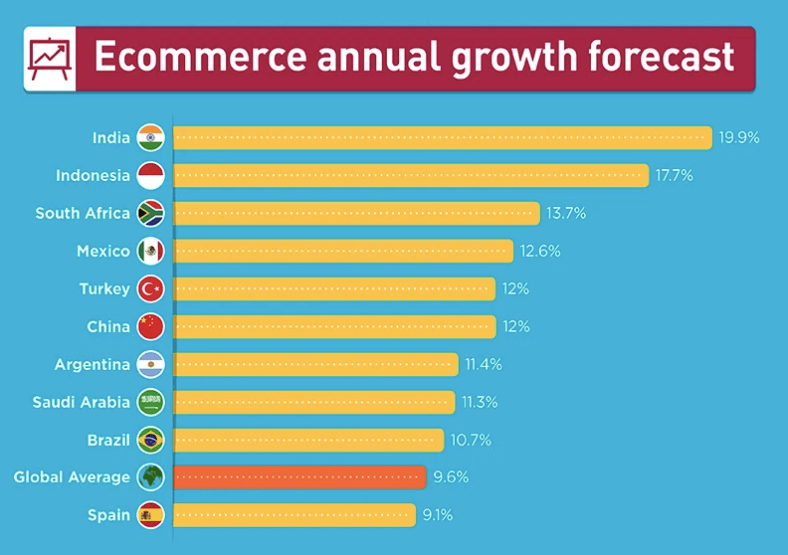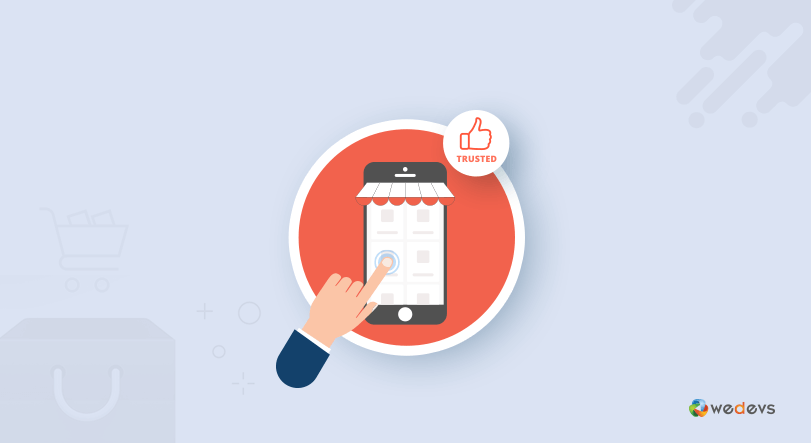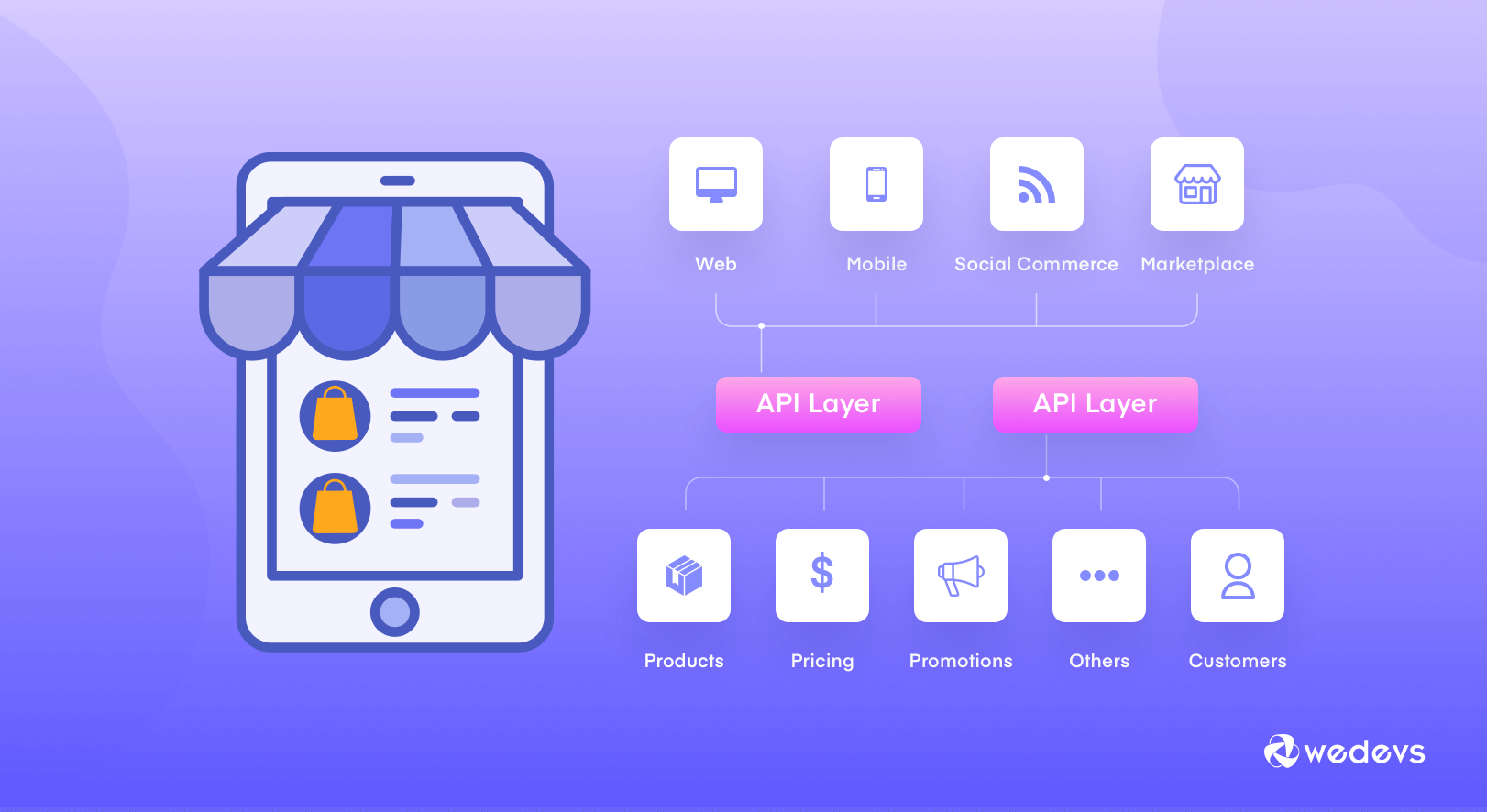![Future eCommerce Trends: 10 Possible Forecasts for 2026 [Updated]](https://cdn.wedevs.com/uploads/2020/01/Forecasting-the-future-of-eCommerce.png)
Future eCommerce Trends: 10 Possible Forecasts for 2026 [Updated]
The eCommerce business is on the rise and will evolve remarkably shortly. It changes customer behavior, needs, and shopping trends a lot. Within 25 years this industry has made over 2 trillion US dollars in sales worldwide.
Adaptation of new technology, large customization, policy evolution, and smart integration with advanced solutions have taken the eCommerce industry by storm.
eCommerce Sales Are Projected to Reach $8.1 Trillion by 2026.
Also, now you can combine the online and offline selling procedures to take maximum advantage of these two channels.
Today we will discuss the Future eCommerce Trends that will reflect the revolving scenario of the eCommerce industry for years to come.
eCommerce Industry Stats: Future of eCommerce
Over the past few years, the eCommerce business has been growing at a meteoric pace. It has left a significant impact on traditional retailing. According to the latest report- around 2.77 billion people are expected to shop online by 2025.
Business-to-business (B2B) eCommerce also shows continuous growth in 2023. Interestingly, customers nowadays prefer eCommerce to brick-to-mortar shopping just to avoid the long queues and annoying traffic. Also, they can read reviews and compare the products while buying online. That's why business owners also set their marketing strategies to get more online traffic rather than foot traffic.
However, China and the USA have a fast-growing eCommerce space and rule the global economy with a great percentage. These are the top 10 countries that are spending money online.
- China – $656.3
- United States – $500.47
- United Kingdom – $83.83
- Japan – $78.64
- Germany – $68.01
- South Korea – $62.69
- France – $45.54
- India – $29.47
- Canada – $28.63
- Australia – $19.33

Future Stats for the eCommerce Industry
Let's see the stats that show the further possible transformation of the eCommerce industry in 2023 and beyond.
- Global eCommerce sales are expected to total $6.3 trillion worldwide in 2024.
- The U.S. eCommerce market will reach over $1.1 trillion in sales.
- In the U.S., 16.4% of retail purchases are expected to take place online.
- By 2040, around 95% of all purchases are expected to be via eCommerce.
- Online stores with a loud social media presence will get 32% more sales on average than those who do not.
- On average, 52% of eCommerce businesses have omnichannel capabilities.
- The Indian eCommerce market is one of the top 5 fastest growing countries in the world, sitting at 25.5% growth in sales in 2022.
- The UK is forecast to continuously increase by $85.7 billion (+42.88%) within the next years.
And these stats do tell us a lot about major changes in consumer behavior that will continue until 2024 and beyond. Digital shoppers should update their business strategies by considering this figure. Otherwise, there is a high risk of collapse.
Future eCommerce Trends Predictions

If you want to keep pace with this moving industry you must be updated with the future eCommerce trends of this space. It will help you to make the customer shopping experience more exciting.
- Increased Adoption of AI and Machine Learning
- Rise of Mobile Shopping
- B2B eCommerce Will Continue to Outperform B2C eCommerce
- Multichannel Personalization
- Voice Shopping to Take Center Stage
- Social Media Enters Online Shopping
- Sustainability and Ethical Shopping
- Headless eCommerce in Game
- Augmented Reality to Visualize Purchases
- Increase Popularity in Subscription Models
1. Increased Adoption of AI and Machine Learning

Artificial Intelligence (AI) and Machine Learning (ML) are set to become even more integral to eCommerce operations. You can use these technologies for personalized shopping experiences, predictive analytics for inventory management, and enhanced customer service through chatbots and virtual assistants.
By integrating AI technology into your business you can analyze the store data and buyer's behavior more efficiently.
78% of eCommerce business owners report they've already implemented AI tools in their online stores or plan to do it in the nearest future.
AI solutions allow brands to better understand their customers and ensure personalized service and marketing. It's projected that AI-powered eCommerce solutions will be worth $16.8 billion by 2030.
Moreover, AI has empowered customers with many high-tech experiences. Such as visual search, personalized recommendation, voice assistant, and so forth. On the other hand, an online seller can improve the pricing module and product representation with the help of AI.
A recent study by Business Insider suggests that more than 85% of customer interactions will be managed by chatbots in the future.
2. Rise of Mobile Shopping

Mobile shopping has been on the rise massively in recent years. Customers from all over the globe intend to purchase products and services using their mobiles or tablets. Online retailers also adopt the mobile-first approach as mobile shopping grows. People are more likely to turn to their smartphones for online purchases.
Mobile commerce accounted for more than 431.4 billion in sales in 2022. And it's projected to increase even further to 511.8 billion in 2023, 604.5 billion in 2024 and 710.42 billion in 2025.
Now the users often use their portable devices to check the products before finalizing the orders. It makes mobile optimization a necessity for online retailers.
So, eCommerce companies must optimize their sites for mobile users if they want to grow the business fast.
3. B2B eCommerce Will Continue to Outperform B2C eCommerce

The new trend of eCommerce has become a game-changer for both B2B and B2C companies. It is being conceived that B2B eCommerce is outpacing B2C, and will soon outperform it. B2B eCommerce entails wholesale distributors selling goods to peer entrepreneurs.
Moreover, B2B minimizes the hassle of manual processes using an online sales portal. It lets businesses sell and distribute the products from one business to another through online channels. It will, however, increase your sales with a stronger online presence at a lower cost.
B2B eCommerce fuels the current global economy. A recent study of Forrester says US business-to-business (B2B) eCommerce will reach $1.8 trillion by 2023.
And they predicted a compound annual growth rate (CAGR) of 10% for B2B eCommerce over the next five years. This report shows the opportunity of the US B2B eCommerce industry. Online merchants are entering this market with the gaining popularity of B2B eCommerce. It will ensure seamless online purchasing experiences for the customers.
How to Convert Leads Into Customers for Your eCommerce Store
4. Omnichannel Retail in eCommerce

Omnichannel retail is a modern sales approach that ensures a unified shopping experience for customers. Multi-channel eCommerce business refers to promoting and selling products on multiple channels including E-Commerce websites, marketplaces, and even offline.
Interestingly, it will blur the distinctions among channels, both physical and online. Customers will have more chances to get information about your products or services. Furthermore, when you will promote your brand in different channels which may increase sales opportunities and brand recognition.
Study shows that 90% of consumers now expect brands to offer omnichannel experiences across their preferred online and in-store channels and touchpoints.
This is why companies that offer robust omnichannel experiences witness a 20% boost in total revenue.
However, customers can visit multiple channels during their shopping process. It lets a user start his/her journey at one channel and complete the purchase at another one. That's why the Omnichannel retail approach has been adopted by different marketing strategies to boost their eCommerce business.
5. Voice Shopping to Take Center Stage
Voice shopping is gradually becoming mainstream for next-generation online buyers. Researchers say more than 50% of the US population uses voice search features daily, and more than one-third (34%) use them at least once a week.
Big shots like Amazon, Alibaba, Walmart, and other giant companies have already introduced voice shopping in their online grocery. This eCommerce trend started getting popular in 2014 when Amazon launched its smart speaker – Echo.
51 percent of all online shoppers in the US use voice assistants to help them research products.
ComScore
You will be amazed to know that more than 30% of US internet users have used a voice assistant to look for product details or purchase products. That's why online retailers spontaneously integrate voice commerce into their businesses. So, the buyers can make purchases using their voices easily.
Voice shopping will make the purchasing process more smooth. Users can search, analyze, compare and buy products by providing a verbal description. These facts and statistics have proved that the number of voice shoppers will dramatically increase in the coming years.
6. Social Media Enters Online Shopping

Social media is not only a channel anymore which connects people together. Besides promoting products or services, social media platforms let retailers sell their products directly. Now, social shoppers can purchase products through the Buy Button on Facebook or Instagram Checkout.
For many people, the social platform is the first point of contact with any business. Nowadays buyers prefer to read reviews from real users. They follow the brands and are more likely to buy products from the ones they follow.
Social Media has the potentiality to increase eCommerce sales by 71%. It is a powerful digital marketing tool to drive sales and long-term loyalty.
SEtalks.com
However, eCommerce owners can get help from Facebook and Instagram influencer to promote their brand widely. Social media exposure will continuously influence your audience to connect with your brand.
Social Media becomes a noteworthy marketing tool to increase loyal advisors with optimal sales for your business. The number of social media users and social influencers is increasing broadly.
Therefore, online retailers should come up with better social marketing strategies to explore more opportunities for their stores.
Read more: How to Sell Products with Your TikTok Business Account.
7. Sustainability and Ethical Shopping
Consumers are increasingly concerned about sustainability and the ethical implications of their purchases. Brands that prioritize sustainability may gain a competitive edge in 2024.
As an eCommerce business owner, you should prioritize transparency, sustainability practices, and ethical sourcing to meet consumer demands. You can also focus on eco-friendly packaging, carbon-neutral shipping options, and platforms dedicated to sustainable products.
8. Headless eCommerce in Game

Headless eCommerce is in growing popularity among shop owners as it makes tasks easier. It uses two different technology the front end and the back end. The regular front end maximizes the utilization of content while the eCommerce back end can effectively run your business activity.
Headless eCommerce de-couples the front end and back end of your eCommerce platform. Suppose a customer clicks on Buy Now, and immediately the store gets a call to retrieve information from the backend. This is the general process of a traditional eCommerce. Headless eCommerce will make the transaction faster by using API to retrieve the information.
Online merchants have a good number of advantages for using Headless eCommerce. Such as:
- Modern technology to create a faster and more catchy website
- Familiar with the web developer
- Ownership of site structure
- Apply a successful marketing campaign without harming the backend eCommerce operation
- Less cost for customer acquisition and retention
- Higher conversion rate compared to traditional websites and eCommerce platforms
Again, it is compatible with open-source applications that enhance expandability.
Learn more about Headless eCommerce: Everything You Need to Know for elevating your online business.
9. Augmented Reality to Visualize Purchases
Online shopping makes modern life easier by bringing everything to your door. Without wasting time in traffic or waiting in the queue now you can make the purchase within a few clicks only. Not only that you get the flexibility to browse a lot of products and compare their price & quality in a faster way. Quick delivery makes the eCommerce shopping experience higher than ever.
Besides so many benefits there is a major downfall in online shopping. You can't see the product in detail every time. Sometimes consumers predict wrong about the product and end up with high dissatisfaction. However, Virtual and Augmented reality can bridge this gap. It provides you with a 360- degree view of any product or place. Therefore you can easily realize how it will serve your purpose in real life.
This means VR gives consumers a virtual tour of how a product actually looks in reality. And AR explains more details to understand whether it meets their needs or not.

You can take the popular makeup brand Sephora as an example. Their ‘Virtual Artist' feature allows customers to try on different products and create different looks on them. This boosts their confidence and ensures a personalized shopping experience. Anyone hardly says NO to this facility, especially fashion lovers.
10. Increasing Popularity of Subscription Models
Digital customers prefer a subscription-based business model to a one-time payment. It makes them confident about their spending. Also, eCommerce owners find it an easier way to onboard new users and make them come to the shop again and again.
This eCommerce model has become popular over the past years. By understanding how it works and setting up a realistic pricing strategy you can build the foundation for your online business. You can charge customers recurring fees monthly or yearly basis to access a product or service. Hence, customers need not pay a large amount at once. Rather they can use the product for a particular time period. And have the freedom to decide either to extend the subscription or not once it expires.
By 2023, subscription eCommerce is expected to generate more than 38 billion dollars in revenue
Companies like Apple Music & Netflix are shifting to Subscription Business models to build long-term relationships with customers and recurring revenues. Plus, digital payment platforms such as PayPal, Stripe, and WePay simplify the process of setting up recurring payments effortlessly. If you want to sustain this business start thinking over this modern technique from today!
Top 10 Proven Ways To Create Urgency And Boost Ecommerce Sales
Bonus: Personalization of Customer Experience

You can make your clients feel special by personalizing his/her shopping experience. Hundreds of new companies are entering the industry every year. It makes the competition so high. If you can't make your clients satisfied s/he have plenty of alternatives in their hands.
eCommerce Personalization lets online traders set digital strategies based on browsing behavior, purchase history, demographics, personal data, and psychographics. So, digital businesses should impose extra effort to personalize the customer's shopping experiences which will improve customer loyalty & sales.
According to a survey, 85% of US marketers believe that their prospects or customers expect a personalized experience.
Online retailers noticed remarkable revenue lifts in their business after personalizing their shops. Therefore, it is the best time when you should treat specifically with each and every client. You have to focus on the customer's individual needs while designing the products and services.
Importance of Knowing Future eCommerce Trends

In order to sustain in this competitive world, you have to stay tuned with the updated eCommerce trends. Your business can lag behind even after having all the essential attributes if you don't monitor the changing forecast of this industry.
Now, it's all about making the user experience better. The success of your eCommerce business largely depends on how easily your site can treat its users. Customers are becoming smarter day by day so you have to upgrade your skills to match their requirements. This situation makes online merchants more tech-friendly than ever before.
As we are moving to 2023, so you must adopt the new eCommerce trends to update your business expansion strategy. Therefore, you can take optimal advantage of this further forecasting. It will keep you always a step ahead of your competitors. And you can expand your eCommerce brand effectively worldwide.
Online Sellers Should Consider the Future eCommerce Trends Before Investing
It must be more comfortable if you can purchase and pay from your home. As an online retailer, you have to make your customers feel that comfort. It will convince them to buy from your shop indeed.
Nevertheless, you should adopt Future eCommerce Trends to set new business models and practices. It will assist you to establish a robust eCommerce business for your users.
Summary: eCommerce Trends 2026
- The global eCommerce growth rate for 2026 is estimated to be 10.4%
- B2B eCommerce market size is expected to expand at a compound annual growth rate of 18.7% from 2021 to 2028
- Mobile commerce will drive more than 50% of total eCommerce sales in 2026
- 74% of customers rely on their social networks to make purchasing decisions
- Chatbots will help businesses save costs of more than $8 billion per year
- 71 percent of customers prefer to conduct queries by voice instead of typing.
- More than 50% of online buyers say a personalized experience is important.
- 74% of marketers believe personalization has a “strong” or “extreme” impact on advancing customer relationships.
If you are an online retailer or planning to start one then you should monitor future eCommerce trends more closely. It will help you to improve your online selling strategy. And you can keep yourself up to date with the constant change in consumer demands.
